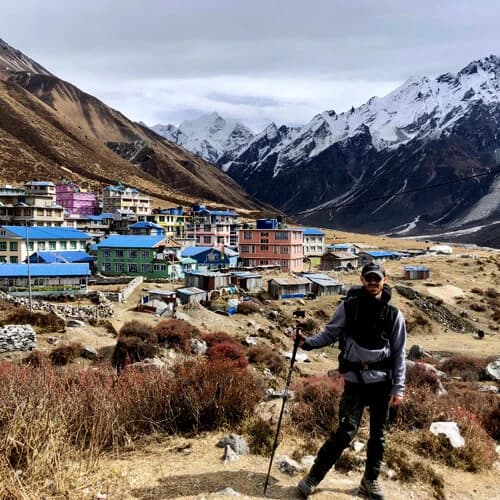The Langtang Valley Trek is one of the most fabulous adventure quests, presenting Himalayan splendor and distinct cultural experiences. It is an excellent option for travelers who are new to high-altitude trekking. The spectacular expedition is the closest you can get to the majestic snow-capped mountains from Kathmandu. The Langtang Valley is located near the Tibetan border and is dominated by the beautiful Langtang Lirung (7,246m), the highest peak in the region. The excellent introductory trek in Nepal also features the Langtang National Park, which offers scenic beauty, exotic wildlife, and a varied landscape. From expert trekkers to novice adventurers, the Langtang Valley Trek is a superb option to experience the serene Himalayan landscape of Nepal. Read further to gain additional information and experience and enjoy the Langtang Trek.
The Ultimate Guide to Langtang Valley Trek
Langtang Valley Trek Route
The Langtang Trek, a journey of approximately 77 km or 48 miles, typically takes 7 to 10 days to complete, depending on your pace and itinerary. Your adventure begins in Syabrubesi and takes you through forests, traditional Tamang villages, and alpine meadows. The first stop is at Lama Hotel on day 2. The next day, you'll continue the hike, heading towards Langtang village on day three and Kyanjin Gompa on Day 4. You'll spend a day at Kyanjin acclimating and then retracing your steps to Lama Hotel, Syabrubesi, and finally, Kathmandu. Along the way, you'll be treated to breathtaking views of Langtang Lirung, Ganesh Himal, and Dorje Lakpa, making this a journey to remember.
Best Time to Trek Langtang Valley
Like any high-elevation trek in Nepal, the Langtang Valley Trek's timing is crucial. To help you plan, here's a brief overview of the region's weather conditions throughout the year. This will help you choose the best time to embark on your Langtang Valley adventure.
Spring (March to May): This season offers clear skies, stable weather conditions, and aesthetic landscapes blooming with exotic wildflowers. The temperature usually ranges from 20 to 25 degrees Celsius during the day and drops to 5 to 10 degrees Celsius at night.
Autumn (September to November): The temperature at this time of the year is optimal for trekking, ranging from 20 degrees Celsius to 30 degrees Celsius during the day and 5 to 10 degrees Celsius at night. A crisp atmosphere, lucid weather, and beautiful views of the mountains characterize autumn.
Summer/Monsoon (May to August): While this might be an attractive time to witness the abundant flora and fauna of the Langtang region, you must also tackle certain challenges along the trail. The temperature is warm, and you will experience heavy rainfall along the trek, which makes the trek slippery and challenging to walk on. We suggest you pack waterproof gear to adjust to these weather conditions.
Winter (December to February): Trekking in the Langtang Valley during the Winter season is mainly preferred by experienced trekkers who seek challenging adventures. As the temperature drops below negative, you will be hiking in a thick layer of snow. The trail will be quieter than usual, with fewer travelers, allowing you to experience the winter wonderland in peace and tranquillity.
Langtang Valley Trek Cost 2024/25
The trek with Outfitter Nepal costs $800, including all transport, accommodations, meals, permits, and government paperwork. For a comprehensive overview of the cost details, please see our complete Langtang Valley Trek package.
How Difficult is the Langtang Trek?
The Langtang Valley trek is graded as a moderate expedition due to its challenging terrain and elevation gain. The maximum altitude you will gain on the trek is 3,800m, and 4,600m if you summit Kyanjin Ri Peak. Regardless, it is one of Nepal's easier and shorter trek routes, suitable for people of all ages. To prepare for the trek ahead, you can indulge in physical activities and training sessions in the gym 1-2 months before the expedition starts.
Langtang Trek Itinerary
Day 1: Kathmandu (1,400 meters/4,600 feet) to Syabrubesi (2,380 meters/ 7,808 feet)
- Distance: 30 km
- Drive: 7-8 hrs
- Accommodation: Tea house
- Meal: Breakfast, Lunch, Dinner
Day 2: Syabrubesi to Lama Hotel (2,480 meters/8,135 feet)
- Distance: 15 km
- Hike: 5-6 hrs
- Ascent: 1,247m
- Descent: 2,78m
- Accommodation: Tea house
- Meal: Breakfast, Lunch, Dinner
- Route: Tiwasi, Pairo, Bamboo, Rimche, Lama Hotel
Day 3: Lama Hotel to Langtang Village (3,500 meters/11,480m)
- Distance: 14 km
- Hike: 4-5 hrs
- Ascent: 1,075m
- Descent: 1,55m
- Accommodation: Tea House
- Meal: Breakfast, Lunch, Dinner
- Route: Riverside Lodge, Ghodatabela, Thyangsyapu, Chamyki, Langtang
Day 4: Langtang Village to Kyanjin Gompa (3,800 meters/12,465 feet)
- Distance: 6.5 km
- Hike: 2-3 hrs
- Ascent: 4,18m
- Descent: 45m
- Accommodation: Tea House
- Meal: Breakfast, Lunch, Dinner
- Route: Mundu, Singdum, Yamphu, Kyanjin Gompa
Day 5: Rest at Kyanjin Gompa - Acclimatization Day
- Hike: 4-5 hrs (Kyanjin Ri, or Tserko Ri)
- Ascent: 8,00-900m
- Accommodation: Tea House
- Meal: Breakfast, Lunch, Dinner
- Route: Kyanjin Ri, Tserko Ri, Kyanjin Gompa
Day 6: Kyanjin Gompa to Lama Hotel
- Distance: 20km
- Hike: 6-7 hrs
- Descent: 1,052m
- Accommodation: Tea House
- Meal: Breakfast, Lunch, Dinner
- Route: Yamphu, Singdum, Mundu, Langtang, Chyamki, Thyangsyapu, Ghodatabela, Riverside Lodge, Lama Hotel
Day 7: Lama Hotel to Syabrubesi
- Distance: 11km
- Hike: 4-5 hrs
- Descent: 1,348m
- Accommodation: Breakfast, Lunch, Dinner
- Meal: Breakfast, Lunch, Dinner
- Route: Rimche, Bamboo, Pairo, Tiwasi, Syabrubesi
Day 8: Syabrubesi to Kathmandu
- Distance: 30 km
- Drive: 7-8 hrs
- Accommodation: Hotel
- Meal: Breakfast, Lunch, Dinner
Accommodation and Food in Langtang Trek
Teahouses: The tea houses along the Langtang trek route offer basic facilities, including a double room, dining area, attached bathroom, hot shower, blankets, electricity, and wifi. Remember that the facilities might get scarce as you ascend to higher elevations.
Food: The menu items are similar in most of the tea houses in the Langtang Valley. Some popular items include dal bhat tarkari, oatmeal, Tibetan bread, scrambled eggs, chapati, and thukpa. You will also have options of Western delicacies such as pizza, macaroni, pasta, etc. In terms of drinking water, you can get it from the tea houses as well. We recommend that you use water purification tablets to prevent yourself from illness.
Permits and Regulations
For Langtang Valley trekking, you'll need the following permits:
1. Langtang National Park Entry Permit
- Cost: NPR 3,000 (approximately $30)
- Where to Obtain it: Kathmandu, Nepal Tourism Board office or Dhunche, entry point to the park
2. TIMS Card
- Cost: NPR 1,000 (about the equivalent of USD 10) for solo trekkers and NPR 2,000 (about the equivalent of USD 20) for group trekkers.
- Where to obtain: Kathmandu, the Nepal Tourism Board office, or trekking agencies.
3. Shivapuri National Park Entrance Fee(Depends in the trek you choose)
- Cost: NPR 5,00 (Approximately $5)
- Where to obtain: Kathmandu, the Nepal Tourism Board office, or trekking agencies.
What to Pack
Here is our essential packing list for the Langtang Valley trek. The following gear and clothing will help you adjust to the region's climate and landscape.
Clothing:
- Base Layers: Fast-drying shirts and innerwear.
- Mid Layers: Fleece jacket; insulated vest.
- Outer Layers: Waterproof and windproof jacket and pants.
- Headwear: A warm or sun hat; a buff or scarf.
- Footwear: Waterproof Trekking boots and several pairs of socks made of moisture-wicking fabric.
- Accessories: Ggloves, sunglasses, and trekking poles.
Gear:
- Backpack: A comfortable daypack of around 30-40 liters.
- Sleeping Bag: Comfort temperature rating -10°C to -15°C / 14°F to 5°F.
- Hydration System: Water bottles or hydration bladders
- First Aid Kit: Bandages, antiseptics, pain relievers, and personal medication.
Miscellaneous :
- Headlamps, batteries, sunscreen, lip balm, toiletries, and snacks.
Health and Safety Advice
Proper Acclimatisation
- Rest day is for your body to acclimatize in the high altitude region.
- Keep yourself hydrated and maintain a good hydration level. Avoid alcohol and caffeine.
Watch for AMS Symptoms
- Observe for headache, dizziness, nausea, or short breath
- If symptoms persist, notify your trek guide so that you can be prescribed the proper medications.
Safety on the Trail
- Heed your guide's advice without fail and respect the customs and rules of the country.
- Watch your steps on steep and rockladen stretches, and use trekking poles for balance.
Sustainable Practices
- Adopt the ideals of Leave No Trace; carry out all your trash and leave a minimum environmental footprint.
- Use biodegradable toilet soap and other toiletries.
Guide and Porters
Travelers must hire an experienced and licensed guide while trekking in high-altitude regions of Nepal. They will help you navigate the route and inform you about the landscape, local culture, customs, traditions, and history. On the other hand, hiring a porter will ease the physical burden on your body, allowing you to experience the trek comfortably and efficiently.
Passport & Visa
All clients seeking to begin their adventure in Nepal must have a six-month valid passport. You can obtain the visa upon arrival at the Tribhuvan International Airport or apply online and print the receipt, which you must submit to the Immigration Officer upon arrival.
Travel Insurance
We highly recommend that you have comprehensive travel insurance covering your repatriation expenses, injuries, medical expenses, and emergency evacuation. Before you book a trek with us, you must also ensure that your insurance includes helicopter evacuation over 5,000m.
Some Most Popular Treks
- Everest Base Camp Trek - 14 Days
- 12 Days Everest Base Camp Trek
- Everest Base Camp Luxury - 14 Days
- Everest Cho La Pass - 17 Days
- Everest High Pass 16 - Days
- Annapurna Base Camp - 13 Days
- Ghorepani Poon Hill - 7 Days
- Annapurna Circuit - 17 Days
- 12 Days Annapurna Circuit Trek
- Manaslu Circuit - 14 Days
- Manaslu Trek 12 Days
- Everest Base Camp with Island Peak - 16 Days
- Everest Luxury Trek with Helicopter Return
- Langtang Valley - 10 Days



